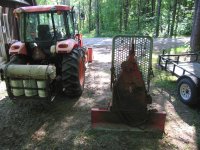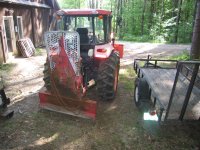Wagtail
Super Star Member
- Joined
- Jan 15, 2013
- Messages
- 12,840
- Location
- St Helens, Tasmania, Australia
- Tractor
- JD 4105 / JD Z355E (48" deck)
I run a specific 3PH ballast box as a typical counterbalance to my FEL and whichever attachment I have on there and what task I'm going to use that attachment for. The ballast box is loaded with bricks, which can be added/subtracted to adjust the weight, plus the height at which I 'carry' it adds to the balance and 'centre of gravity' and stability. Ideally, I'd love to get my hands on the rectangular weights of a broken weight/exercise contraption to replace the bricks.
I typically run bale-spikes on my FEL so my brick-laden ballast box, carried low, is good to handle/transport a 6x5 round bale. "Low and slow" is the mantra for any FEL work. If I'm running my tiller or slasher off of the 3PH, I'll always put my 4in1 bucket on the FEL to counterbalance.
There are threads here on TBN of people making 3PH counterweights... however, they're of a fixed weight, typically due to the use of concrete used to form them.
(I know that you're not a 'newbie', Mate. I'm writing most of this response to someone who is reading this thread as a 'newbie'. :thumbsup
I typically run bale-spikes on my FEL so my brick-laden ballast box, carried low, is good to handle/transport a 6x5 round bale. "Low and slow" is the mantra for any FEL work. If I'm running my tiller or slasher off of the 3PH, I'll always put my 4in1 bucket on the FEL to counterbalance.
There are threads here on TBN of people making 3PH counterweights... however, they're of a fixed weight, typically due to the use of concrete used to form them.
(I know that you're not a 'newbie', Mate. I'm writing most of this response to someone who is reading this thread as a 'newbie'. :thumbsup


